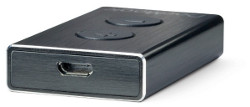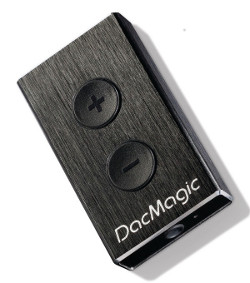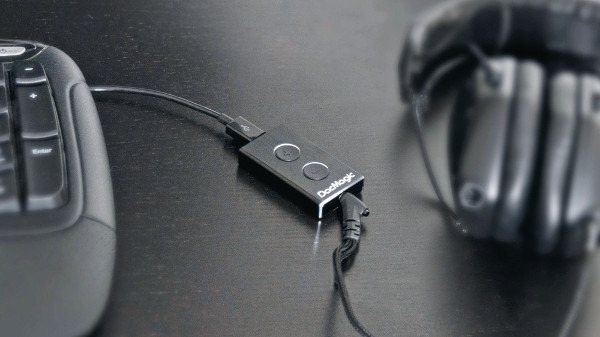Just don't make sense to me @ all; performance is less than satisfactory (3.5 stars) and yet the value is excellent (5 stars)!
See what I mean.

AT A GLANCE
Plus
Inexpensive
Compact
192-kHz capable
Minus
Potential dynamic limits
Runs warm
THE VERDICT
Though not ideal for more demanding headphones with challenging music, this is a highly affordable way to improve computer audio.
Bits are helpless prisoners trapped on the hard drive of your computer. If you plug your headphones (or desktop audio system) into the computer’s analog output, you can faintly hear their cries for help, but not the true timbre of their colorful voices. It takes a USB DAC (digital-to-analog convertor) to truly liberate them. And the good news is that USB DACs—especially those suitable for headphones—have gotten so small and unintrusive that you hardly notice their presence. A product like Cambridge Audio’s DacMagic XS is no bigger than a USB thumb drive. But the difference it can make to your computer audio listening life is very big indeed.
About 2 inches long, the device’s casing is black brushed aluminum, not plastic, with shiny accents on the end caps and a pinpoint LED to indicate USB mode. Two buttons adjust volume and toggle between USB Audio Class 1.0 mode and Audio Class 2.0 mode (which allows the highest sampling rates). There’s a Micro USB jack at one end and an analog mini-jack at the other; a 6-inch cable adapts the Micro USB to full-size USB. The imposition of the short cable prevents you from plugging XS directly into your computer. But it also prevents you from smacking the device and damaging it or the computer’s USB jack.
 To get the full resolution of which XS is capable—the 192- and 176.4-kilohertz sampling rates—you have to switch it into USB Audio Class 2.0 mode by holding down both volume buttons, then (if you’re running Windows) install the USB driver available on the Cambridge Audio website. If the device is not in the correct mode, the driver will not install. Once the driver is running, you can enable XS in the computer’s control panel, maximize resolution at 192 kHz, and select XS in the music app. Using Foobar 2000 on my Lenovo Win 7 multimedia desktop and laptop PCs, I selected the XS to run in ASIO mode, the highest-quality choice.
To get the full resolution of which XS is capable—the 192- and 176.4-kilohertz sampling rates—you have to switch it into USB Audio Class 2.0 mode by holding down both volume buttons, then (if you’re running Windows) install the USB driver available on the Cambridge Audio website. If the device is not in the correct mode, the driver will not install. Once the driver is running, you can enable XS in the computer’s control panel, maximize resolution at 192 kHz, and select XS in the music app. Using Foobar 2000 on my Lenovo Win 7 multimedia desktop and laptop PCs, I selected the XS to run in ASIO mode, the highest-quality choice.
Before you start listening it would be prudent to decide how to handle volume. Once you select the “CA USB 1.0 (or 2.0) Audio” option for your computer’s output in the computer’s audio preferences, the computer’s output volume defaults to maximum gain and can’t be adjusted down via keyboard or mouse. Cambridge says they max out the soundcard and take over the gain function to prevent a duplicative gain loop in both the computer sound card and the XS, and to avoid the chopping of word length that some soundcards employ to reduce gain, which they deem an unacceptable sacrifice in potential resolution. At that point, you might still be tempted to max out the volume control buttons on the XS and use the gain control available in your iTunes or other player software. But don’t—or you might find the player software also truncates word length when attenuating volume. As the best option, Cambridge recommends you max out your iTunes or other player software, and just let the XS’s 53-step analog gain section do the work of controlling volume.
While the XS is designed more for headphones than for desktop audio systems, it can serve both purposes. I did a little preliminary listening with the XS feeding my 2.1-channel desktop system, featuring a Peachtree Decco2 amp and Era Design 4 speakers. It had a good overall tonal balance with a mild rolloff at the top. It was not entirely transparent—nor would I expect it to be.
 Properly used, with headphones, the XS made modest improvements over the PC’s analog output. In Pink Floyd’s Dark Side of the Moon (2011 remaster, FLAC rip from CD) the balance of frequencies was about the same. I could not hear any difference in bass. But the top end was more refined, making the cymbals slightly less prominent but more realistic. Double-tracked voices were less metallic, more organic. The differences were subtle but real, and the longer I listened, the more I appreciated them.
Properly used, with headphones, the XS made modest improvements over the PC’s analog output. In Pink Floyd’s Dark Side of the Moon (2011 remaster, FLAC rip from CD) the balance of frequencies was about the same. I could not hear any difference in bass. But the top end was more refined, making the cymbals slightly less prominent but more realistic. Double-tracked voices were less metallic, more organic. The differences were subtle but real, and the longer I listened, the more I appreciated them.
Of course performance varied somewhat according to the headphones used. The XS got higher gain and better-balanced sound from the closed-back 32-ohm Bose TriPort. It even approximated the bass pedals in the final movement of the Saint-Saëns Organ Symphony (Munch, Boston, 24/176.4, HDtracks). My longtime reference AKG K240, on the other hand, was a tougher load. The little XS drove these semi-open 55-ohm headphones sufficiently loud with rock and pop, but couldn’t drive them loud enough for the full dynamics of the Saint-Saëns. And with any content, the AKG seemed muddy and sloppy overall through the XS—a problem it doesn’t have with, say, a Woo WA6 tube headphone amp or even the headphone output of my Pioneer VSX-53 receiver. To be fair though, both of those units operate off of mains power so have the luxury of greater power resources than would be expected of the tiny XS and its USB-supplied power.
Compared to what is probably its chief competition, the AudioQuest DragonFly, the XS provided a strong contrast. It is not better but quite different. The propensity of the DragonFly is unabashedly midrange-centered and sounds markedly different from the internal output of my laptop. The XS has a more pronounced and open top end and doesn’t reimagine recordings as aggressively. If you hate fumbling with volume bars on your computer, you might appreciate Cambridge’s hard volume buttons, though its tiny sampling-rate LED is a poor substitute for AudioQuest’s dramatically lit-up dragonfly-silhouette indicator. Support of 192- and 176.4-kHz sampling rates is another plus, though in such a pragmatically priced product, the improvement over the DragonFly’s 96-kHz limit is minimal. These two products differ more in voicing than in resolution.
In use, the XS also gets a bit warm to the touch, but the manual says this is normal, and presumably the manufacturer doesn’t consider it a problem.
If you’re looking for a USB DAC that will improve computer audio—but not break the bank—Cambridge Audio’s DacMagic XS is a leading contender. Bear in mind that if you’ve spent a significant sum on high-end headphones that present a demanding load, it’s not a substitute for a high-end headphone amp. But for mere mortals using typical headphones, it brings enough pleasure to earn back its modest price several times over.

* Audio editor Mark Fleischmann is also the author of the annually updated book Practical Home Theater (quietriverpress.com).


But I got you now, thx for the explain.
Thin line between overall performance and value? ...You bet, and that line is different for each individual. This one is your own line. :-)

Mark,
ASIO is really not the best format for any Class 1 or Class 2 USB Audio device. In my experience some of the ASIO's we have tested are not even bit true. For Windows 7/8 WASAPI event style is the best sounding interface. WASAPI is available for Foobar, but not event style. You would have to go to J River for that option.
We are writing a white paper in regards to reviewing these little critters. One thing to note is evaluation of cold units (i.e. just plugged in) will not function nearly as well as one that is warmed up for a few hours. Phase noise and jitter can vary widely during this time. So critical listening and evaluation should be done with the unit plugged in for at least 24 hours.
Thanks,
Gordon

I read with interest your review of the Cambridge Audio DacMagic XS USB DAC, and had a couple of thoughts. I would have guessed that a DAC for a PC would totally bypass the PC's sound card, and access the FLAC file directly. It would have its own buffer and its driver would include its own user interface (player). The fact that one uses a separate player (such as iTunes or Foobar), even at full volume, might possibly manipulate the digital stream before getting to the DAC. Plus, if the stream passes through the PC's sound card ("Cambridge says they max out the soundcard and take over the gain function ..."), the quality could be limited by the ability of that sound card. Perhaps one could assume that at full volume, the bit stream remains intact passing through the sound card; I don't know. What if the sound card isn't capable of passing 192-kHz?
Secondly, I found it strange that Mr. Fleischmann would use a FLAC rip from a CD (44.1-kHz) to evaluate a DAC capable of converting 192-kHz sampling rates. If the quality of the audio output is "... more refined ..." and "... more realistic ..." than the PC's analog output, is that because the DAC upconverted it to a higher sampling rate before converting to analog, or the ripping software upconverted it, or did the DAC convert a 44.1-kHz FLAC file to analog better than the PC's sound card otherwise might have?